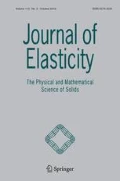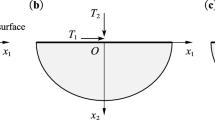Abstract
An instantaneous sub-surface disturbance in a two-dimensional elastic half-space is considered. The disturbance propagates through the elastic material until it reaches the free surface, after which it propagates out along the surface. In conventional theory, the free-surface conditions on the unknown surface are projected onto the flat plane \(y = 0\), so that a linear model may be used. Here, however, we present a formulation that takes explicit account of the fact that the location of the free surface is unknown a priori, and we show how to solve this more difficult problem numerically. This reveals that, while conventional linearized theory gives an accurate account of the decaying waves that travel outwards along the surface, it can under-estimate the strength of the elastic rebound above the location of the disturbance. In some circumstances, the non-linear solution fails in finite time, due to the formation of a “peakon” at the free surface. We suggest that brittle failure of the elastic material might in practice be initiated at those times and locations.







Similar content being viewed by others
Notes
We used the symbolic manipulation language mathematica to find the roots, and they were then verified by hand
References
Aki, K., Richards, P.G.: Quantitative Seismology, 2nd edn. University Science Books, Mill Valley (2009)
Worden, K.: Rayleigh and Lamb waves – basic principles. Strain 37, 167–172 (2001). https://doi.org/10.1111/j.1475-1305.2001.tb01254.x, published online
Kausel, E.: Lamb’s problem at its simplest. Proc. R. Soc. A. 469, 20120462 (2012)
Lan, H., Zhang, Z.: Comparative study of the free-surface boundary condition in two-dimensional finite-difference elastic wave field simulation. J. Geophys. Eng. 8, 275–286 (2011)
Lenells, J.: Traveling waves in compressible elastic rods. Discrete Contin. Dyn. Syst., Ser. B 6, 151–167 (2006)
Xie, S., Wang, L., Rui, W.: Peakons in a generalized compressible elastic rod wave equation. Int. J. Math. Sci. 6, 253–261 (2007)
Lardner, R.W.: Waveform distortion and shock development in nonlinear Rayleigh waves. Int. J. Eng. Sci. 23, 113–118 (1985)
Pal, R.K., Ruzzene, M., Rimoli, J.J.: A continuum model for nonlinear lattices under large deformations. Int. J. Solids Struct. 96, 300–319 (2016)
Forbes, L.K.: Forced transverse oscillations in a simple spring–mass system. SIAM J. Appl. Math. 51, 1380–1396 (1991)
Amabili, M.: Nonlinear damping in large-amplitude vibrations: modelling and experiments. Nonlinear Dyn. 93, 5–18 (2018)
Maugin, G.A.: Nonlinear surface waves and solitons. Eur. Phys. J. Spec. Top. 147, 209–230 (2007)
Wang, X., Fu, Y.: Wrinkling of a compressed hyperelastic half space with localized surface imperfections. Int. J. Non-Linear Mech. 126, 103576 (2020)
Clayton, J.D., Knap, J.: A geometrically nonlinear phase field theory of brittle fracture. Int. J. Fract. 189, 139–148 (2014)
Pouget, J., Maugin, G.A.: Nonlinear dynamics of oriented elastic solids. I. Basic equations. J. Elast. 22, 135–155 (1989)
Pouget, J., Maugin, G.A.: Nonlinear dynamics of oriented elastic solids. II. Propagation of solitons. J. Elast. 22, 157–183 (1989)
Ockendon, H., Ockendon, J.R.: Waves and Compressible Flow, 2nd edn. Springer, New York (2015)
Walters, S.J., Forbes, L.K., Reading, A.M.: Analytic and numerical solutions to the seismic wave equation in continuous media. Proc. R. Soc. A 476, 0200636 (2020)
Diaz, J., Ezziani, A.: Analytical solution for waves propagation in heterogeneous acoustic/porous media. Part I: the 2D case. Commun. Comput. Phys. 7, 171–194 (2010)
Diaz, J., Ezziani, A.: Analytical solution for waves propagation in heterogeneous acoustic/porous media. Part II: the 3D case. Commun. Comput. Phys. 7, 445–472 (2010)
Min, D.-J., Shin, C., Yoo, H.S., Hong, J.K., Park, M.-K.: Free-surface boundary condition in finite-difference elastic wave modeling. In: Conference Paper: 64th EAGE Conference & Exhibition Florence, Italy, pp. 27–30 (2002)
Salupere, A., Tamm, K.: On the influence of material properties on the wave propagation in Mindlin-type microstructured solids. Wave Motion 50, 1127–1139 (2013)
Jinggang, Q.: The new alternating direction implicit difference methods for the wave equations. J. Comput. Appl. Math. 230, 213–223 (2009)
Williams, M.L.: Stress singularities resulting from various boundary conditions in angular corners of plates in extension. J. Appl. Mech. 19, 526–528 (1952). https://authors.library.caltech.edu/47672/
Moore, D.W.: The spontaneous appearance of a singularity in the shape of an evolving vortex sheet. Proc. R. Soc. A. 365, 105–119 (1979)
Krasny, R.: Desingularization of periodic vortex sheet roll-up. J. Comput. Phys. 65, 292–313 (1986)
Forbes, L.K.: The Rayleigh-Taylor instability for inviscid and viscous fluids. J. Eng. Math. 65, 273–290 (2009)
Yuan, Z., Kardomateas, G.A., Frostig, Y.: Geometric nonlinearity effects in the response of sandwich wide panels. J. Appl. Mech. 83, 091008 (2016)
Changchuan, X., Chao, A., Yi, L., Chao, Y.: Static aeroelastic analysis including geometric nonlinearities based on reduced order model. Chin. J. Aeronaut. 30, 638–650 (2017)
Stölken, J.S., Kinney, J.H.: On the importance of geometric nonlinearity in finite-element simulations of trabecular bone failure. Bone 33, 494–504 (2003)
Mihai, L.A., Goriely, A.: How to characterize a nonlinear elastic material? A review on nonlinear constitutive parameters in isotropic finite elasticity. Proc. R. Soc. A 473, 20170607 (2017)
Ames, W.F.: Numerical Methods for Partial Differential Equations, 2nd edn. Academic Press, New York (1977)
Acknowledgements
This research was supported in part by Australian Research Council grant DP190100418. The authors are grateful to the two anonymous Referees, whose comments have led to significant improvements in this manuscript.
Author information
Authors and Affiliations
Corresponding author
Ethics declarations
Conflict of Interest
The authors declare that they have no conflict of interest.
Additional information
Publisher’s Note
Springer Nature remains neutral with regard to jurisdictional claims in published maps and institutional affiliations.
Appendix
Appendix
In this Appendix, we derive the stability condition for the explicit finite-difference scheme (17) presented in Sect. 3.1. To do this, we employ von Neumann’s Fourier stability method [31, Sect. 2-2].
Since the difference scheme (17) is linear, any error introduced into the scheme satisfies the same equations, and the purpose of a stability analysis is to determine whether that error grows or decays as the index \(k\) (corresponding to time) increases. We suppose that the errors have a Fourier form
in which the two constants \(p\) and \(q\) depend on the details of the numerical grids in the variables \(x\) and \(y\). These forms (58) are substituted into the numerical scheme, and after some analysis it is found that the two growth factors \(A_{k}\) and \(B_{k}\) satisfy the coupled linear difference scheme
In this scheme, we have defined three additional constants for convenience. They are
Here, the two grid-based constants \(r\) and \(s\) are
and the two remaining constants \(P\) and \(Q\) involve the Fourier modes \(p\) and \(q\) in the assumed form (58) for the errors in the scheme; they are
The coupled difference scheme (59) can be written as the single fourth-order linear difference equation
and since this has constant coefficients, its solution may be sought by assuming \(A_{k} \sim \xi ^{k}\). It follows at once that \(\xi \) must solve the quartic polynomial equation
Stability of the original system (17) is now determined by the four roots \(\xi \) of this equation, since if \(| \xi | < 1\) then \(A_{k}\) and \(B_{k}\) will remain bounded as \(k \rightarrow \infty \) and in this case, errors will not grow and the system will therefore be stable.
Remarkably, the four roots \(\xi \) of (63) can be written in fairly simple closed form.Footnote 1 They are
in which
This leads at once to the following result:
Lemma 1
The system is stable if \(| \rho | < 1\) and it is unstable if \(| \rho | > 1\).
Proof
If \(| \rho | < 1\), then from (64) all roots are complex and
In this case, the absolute value is \(| \xi | = 1\). Consequently the error neither grows nor decays, so that the system is non-dissipative and stable. Conversely, if \(| \rho | > 1\), then the two options for \(\xi \) in (64) are both real and \(| \xi | > 1\) for at least one of them. The error amplitude \(A_{k} \sim \xi ^{k}\) thus grows without bound and the system is therefore unstable. □
We now state our main result.
Theorem 1
If
the explicit finite-difference scheme (17) is stable.
Proof
If condition (67) holds, then after some algebra, (60) demonstrates that
both apply. These two inequalities then show that
These can be manipulated further to give
From this result, it follows that
using the definition (65). Thus \(| \rho | < 1\) and by Lemma 1 the system is stable. □
In addition to finding the condition (67) that is necessary for stability, it is also possible to determine when the scheme is guaranteed to be unstable. This is summarized in the following result:
Theorem 2
If
(and \(\alpha > 1\)), the explicit finite-difference scheme (17) is unstable.
Proof
In the application of the numerical scheme (17), all the Fourier modes (58) will be present, including some for which \(P = 1\) and \(Q = 1\) in (62). For those modes, (65) shows that
Since \(\alpha ^{2} > 1\), it follows that, for these modes,
Now if the condition (69) holds, then these modes will have the property that \(\rho < - 1\). In that case, Lemma 1 shows that the difference scheme (17) is unstable. □
Theorems 1 and 2 can be regarded as a generalization of the Courant-Friedrichs-Lewy condition in the numerical solution of hyperbolic partial differential equations [31].
Rights and permissions
About this article
Cite this article
Forbes, L.K., Walters, S.J. & Reading, A.M. Large-Amplitude Elastic Free-Surface Waves: Geometric Nonlinearity and Peakons. J Elast 146, 1–27 (2021). https://doi.org/10.1007/s10659-021-09852-6
Received:
Accepted:
Published:
Issue Date:
DOI: https://doi.org/10.1007/s10659-021-09852-6




